Alternate Routing for Location Routing Number (ARLRN) - V7.0
CenturyLink™ has reviewed its current Single Location Routing Number (SLRN) process and is changing the SLRN process to Alternate Routing for Location Routing Number (ARLRN) process for CLECs and WSPs in order to be more closely aligned with industry guidelines. Those customers who currently have SLRN routing in place are NOT required to make any changes in their embedded network and all new routing requests will follow the ARLRN process.
Description
Alternate Routing for Location Routing Number (ARLRN) is a process that enables CenturyLink to route Local Number Routing (LRN) traffic to new or existing Local Interconnect Services (LIS) trunks or Wireless Type 2 Interconnect Services (Type 2) trunks at the end office or local tandem, with a minimum of one LRN per switch, per Local Access and Transport Area (LATA). CLECs or WSPs may maintain existing SLRN arrangements or may request a transition from existing SLRN to ARLRN arrangements as a project, however new SLRN requests will not be offered.
Additional LIS and Type 2 trunk information is described in the following PCATs:
Background
In order to assign a LRN, you must obtain an NPA-NXX from the North American Numbering Plan Administrator (NANPA) for each LNP capable switch. Refer to Local Number Portability (LNP), Product Description Section, for additional LRN assignment information.
The industry LRN Assignment Practices were developed by the Industry Numbering Committee (INC) and issued by the Alliance for Telecommunications Industry Solutions (ATIS) on July 13, 1998, and Technical Requirements No. 2 prepared April, 1999 by the T1S1.6 Working Group on Number Portability and issued by ATIS.
Specifically, the INC practice states that a NXX will not be assigned to a service provider for the sole purpose of establishing a LRN unless that service provider's switch or Point of Interconnection (POI) does not yet have an LRN for the LATA where they intend to provide service. The T1S1.6 technical requirement state: "only one NPA-NXX is needed for the first 6-digits of an LRN per LATA to identify the switch LRN".
LRN
CenturyLink supports one LRN per LATA. Typically, LRNs will route the same as the NPA-NXX they are a part of, therefore, if the NPA-NXX of the LRN is outside of the local calling area of the end office, the traffic will route to the access tandem and then to you. The routing of local LRN traffic via the access tandem and toll trunks will occur even if you have LIS or Type 2 trunks in place at the end office or local tandem unless ARLRN is requested.
Alternate Routing for Location Routing Numbers (ARLRN)
Alternate Routing for Location Routing Numbers (ARLRN) allows one or more LRNs to be routed on a single trunk group at end offices or local tandem. When requesting ARLRN, you are directing CenturyLink, via an ASR or CORR form, to route your LRN on your new or existing LIS or Type 2 trunks at the end office for CenturyLink originated traffic or at the local tandem for un-queried non-CenturyLink originated traffic instead of routing the traffic to the access tandem and then on to you. CenturyLink will translate using a 6-digit (NPA-NXX) routing scheme.
Diagrams
The following diagrams provide examples of CenturyLink's Network Configuration for ARLRN , Default LRN and Embedded SLRN.
Example 1a; ARLRN routing with Local Tandem trunking when the NPA-NXX of the LRN is outside the local calling area:
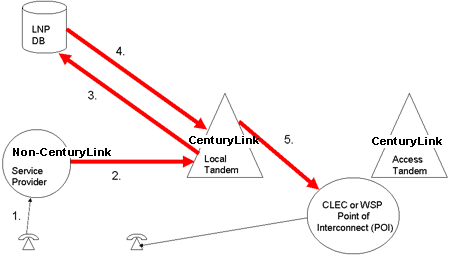
- Non-CenturyLink customer calls a local ported number served by a CLEC or WSP.
- Non-CenturyLink service provider sends local call to local tandem un-queried.
- LNP query is performed at the local tandem.
- LRN returned is to an NXX outside the local calling area.
- CenturyLink routes the LRN based on the first 6 digits (NPA-NXX) of the LRN to LIS or Type 2 local tandem trunk group per customer ARLRN request via ASR or CORR form (multiple LRN per trunk group).
Example 1b; ARLRN routing with Direct End Office Trunking (DEOT) when the NPA-NXX of the LRN is outside the local calling area:
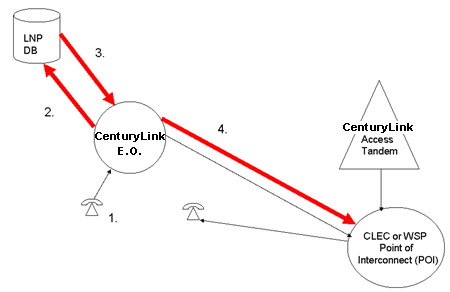
- CenturyLink customer calls a local ported number served by a CLEC or WSP.
- CenturyLink end office performs LNP query.
- LRN returned is to an NXX outside the local calling area.
- CenturyLink routes the LRN based on the first 6 digits (NPA-NXX) of the LRN to LIS or Type 2 DEOT group per customer ARLRN request via ASR or CORR form (multiple LRN per trunk group).
Special Note regarding Direct End Office Trunk Groups with ARLRN routing:
When a call originates from CenturyLink telephone numbers that are presubscribed to CenturyLink LPIC 5123 and resides in that same end office as the DEOT group where ARLRN is requested on a LIS or Type 2 DEOT group, Intra-LATA toll calls dialed to the same NPA-NXX as your LRN will be routed like the LRN.
Default LRN Routing
If the CenturyLink switch recognizes the NPA-NXX of the LRN for the ported telephone number (TN) as being outside the local calling area, local calls will be routed via toll trunks to the CenturyLink Access Tandem. Calls are then delivered to your Point of Interface (POI) via LIS or Type 2 trunks connected to the access tandem.
Example 2a: CenturyLink or Non-CenturyLink queried calls with LRN outside of local calling area
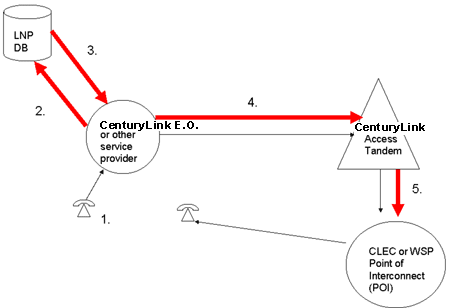
- CenturyLink or non- CenturyLink customer calls local ported number served by a CLEC or WSP.
- LNP query is performed.
- LRN returned is outside the local calling area.
- CenturyLink or non- CenturyLink service provider routes the LRN on 6 digits (NPA-NXX) as if dialed by subscriber to access tandem.
- CenturyLink routes to LIS or Type 2 trunk groups through the access tandem.
Example 2b - Non-CenturyLink non-queried calls with LRN outside of local calling area when ARLRN is not requested:
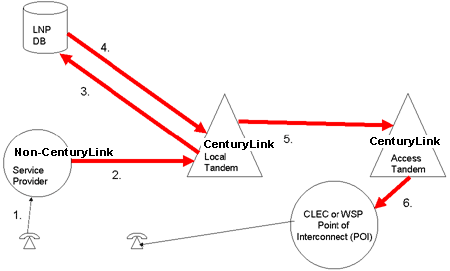
- Non-CenturyLink customer calls a local ported number served by a CLEC or WSP.
- Non-CenturyLink service provider sends local call to local tandem un-queried.
- LNP query is performed at the local tandem.
- LRN returned is outside the local calling area.
- CenturyLink routes the LRN based on the first 6 digits (NPA-NXX) to access tandem on CenturyLink ARLRN infrastructure trunking.
- CenturyLink routes to LIS or Type 2 trunk groups through the access tandem.
Embedded SLRN Network (not available for new routing requests)
Example 3a – CenturyLink SLRN routing with Local Tandem trunking when the NPA-NXX of the LRN is outside the local calling area:
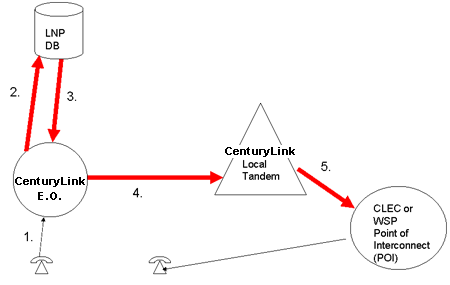
- CenturyLink customer calls a local ported number served by a CLEC or WSP.
- CenturyLink End office performs LNP query.
- LRN returned is outside local calling area and SLRN has been implemented at local tandem.
- CenturyLink routes the LRN on 10-digits (NPA-NXX-XXXX) to local tandem [except Ericsson (AXE) switches route 6-digits].
- CenturyLink routes the LRN on 10-digits (NPA-NXX-XXXX) to LIS or Type 2 on local tandem trunk group (one LRN per trunk group).
Example 3b – Non-CenturyLink un-queried SLRN routing with Local Tandem trunking when the NPA-NXX of the LRN is outside the local calling area:
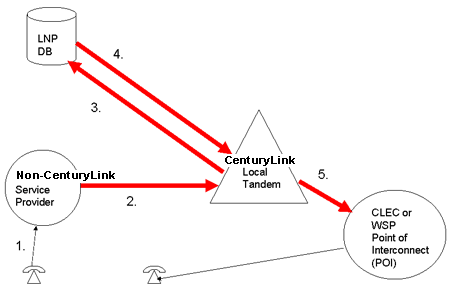
- Non-CenturyLink customer calls a local ported number served by CLEC or WSP.
- Non-CenturyLink service provider sends call to local tandem un-queried.
- LNP query is performed by local tandem.
- CenturyLink routes the LRN on 10 digits (NPA-NXX-XXXX) to LIS or Type 2 local tandem trunk group (one LRN per trunk group).
Example 3c – CenturyLink SLRN routing with Direct End Office Trunking (DEOT) when the NPA-NXX of the LRN is outside the local calling area:

- CenturyLink customer calls local ported number served by a CLEC or WSP.
- CenturyLink end office performs LNP query.
- LRN returned is outside the local calling area.
- CenturyLink routes the LRN on 10 digits (NPA-NXX-XXXX) to LIS or Type 2 DEOT trunk group [except Ericsson (AXE) switches route 6-digits] (one LRN per trunk group).
Availability
To determine LNP availability, refer to Network Disclosure.
Technical Publications
Design requirements are specified in Technical Publication Qwest Common Channel Signaling (CCS) Network Interface Specification - 77342.
Implementation
Prerequisites
If you are a new CLEC and are ready to do business with CenturyLink, view Getting Started as a Facility-Based CLEC or Getting Started as a Reseller. If you are an existing CLEC wishing to amend your Interconnection Agreement or New Customer Questionnaire, additional information is located in the Interconnection Agreement.
Pre-Ordering
Pre-Ordering section does not apply to ARLRN.
Ordering
Field entry requirements are described in the Access Service Request (ASR) Forms.
Requests to order ARLRN (Alternate Route of LRN) in conjunction with ordering LIS or Type 2 trunk groups are submitted populating the following on the ASR:
- On the Translations Questionnaire (TQ) form; Interconnection Translation Routing section; populate the ARLRN field (the ARLRN field replaces the LRN G field which is no longer valid) with the LRN you wish routed to this trunk group in addition to any local NPA-NXX that should be routed to this group.
If you have existing LIS or Type 2 trunks use the following process to order ARLRN:
- Fill out the CenturyLink NPA-NXX Code Request Routing Form. This form asks you to identify the appropriate trunk groups (using 2-6 codes) that ARLRN per switch per LATA traffic will be pointed to.
- Email the CenturyLink NPA-NXX Code Request Routing Form to routing@centurylink.com or fax to (303) 707-9578. Send a copy of the form to your CenturyLink Service Manager.
- Your CenturyLink Service Manager may schedule a LRN planning meeting to clarify where and how the LRN will be applied within a Local Calling Area (LCA) or LATA. If you have an existing LIS or Type 2 network, your current network configuration will be shared at this meeting. In this meeting, both you and CenturyLink personnel will jointly establish the intervals and implementation date for LRN deployment.
Provisioning and Installation
General provisioning and installation activities are described in the Provisioning and Installation Overview.
Maintenance and Repair
General maintenance and repair activities are described in the Maintenance and Repair Overview.
Training
Local CenturyLink 101 "Doing Business With CenturyLink"
- This introductory web-based training course is designed to teach the Local CLEC and Local Reseller how to do business with CenturyLink. It will provide a general overview of products and services, CenturyLink billing and support systems, processes for submitting service requests, reports, and web resource access information. Click here to learn more about this course and to register.
View additional CenturyLink courses by clicking on Course Catalog.
Contacts
CenturyLink contact information is located in Wholesale Customer Contacts.
Frequently Asked Questions (FAQs)
This section is being compiled based on your feedback.
Last Update: March 13, 2014
